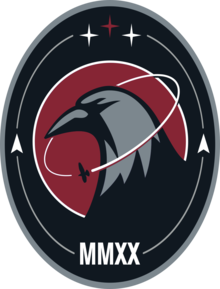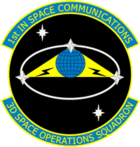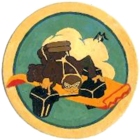| This article needs additional citations for verification. Please help improve this article by adding citations to reliable sources. Unsourced material may be challenged and removed. Find sources: "3rd Space Operations Squadron" – news · newspapers · books · scholar · JSTOR (December 2012) (Learn how and when to remove this message) |
| 3rd Space Operations Squadron | |
|---|---|
 Emblem of the 3rd Space Operations Squadron Emblem of the 3rd Space Operations Squadron | |
| Active | 1941–1947; 1990–13 June 2017; 2020–present |
| Country | |
| Branch | |
| Type | Satellite Operations |
| Role | Combat Support |
| Part of | Space Delta 9 |
| Headquarters | Schriever Space Force Base, Colorado |
| Engagements | American Theater China Burma India Theater Pacific Theater |
| Decorations | Air Force Outstanding Unit Award |
| Commanders | |
| Commander | Lt Col Kenneth P. Grosselin |
| Insignia | |
| 3rd Space Operations Squadron emblem (in use until transfer to the Space Force) |  |
| 3rd Space Operations Squadron emblem (Approved 5 May 1992) |  |
| 3rd Reconnaissance Squadron emblem (Approved 24 July 1943) |  |
The 3rd Space Operations Squadron (3 SOPS) is a United States Space Force unit responsible for conducting on-orbit operations. It is located at Schriever Space Force Base, Colorado.
Mission
The mission of 3 SOPS was to ensure reliable space-borne communications to the President, the Secretary of Defense and U.S. and Allied Forces. The mission is accomplished by conducting launch and on-orbit operations for the Defense Satellite Communications System Phase III satellites and Wideband Global Satellite. These satellites provide secure high-rate data communications links to the President, the Secretary of Defense, theater commanders, and strategic and tactical forces worldwide.
History
World War II
The squadron was first activated at Maxwell Field, Alabama as the 3rd Photographic Squadron under the 1st Photographic Group in May 1941. It performed aerial mapping primarily over the southeastern United States prior to the Pearl Harbor Attack using Bell P-39 Airacobra sub-variants (F-2) which were equipped for the ground-attack and reconnaissance roles. After the United States' entry into World War II, the unit flew aerial mapping missions over the Caribbean and northern South America, mapping various islands for locations of airfields to support the South Atlantic Transport route and Antilles Air Command antisubmarine mission. In addition, it flew aerial mapping missions over Western Canada and the Alaska Territory, mapping uncharted territory to support the building of the Alaska Highway.

The squadron deployed to the China-Burma-India theater in December 1943, performing unarmed long-range mapping of remote areas of the Theater over combat areas in support of ground forces and strategic target identification over Indochina and Malay Peninsula for follow-up raids by XX Bomber Command operating from India.
The 3d returned to the United States in early 1944 and was re-equipped with very long range Boeing B-29 Superfortresses converted to F-13A reconnaissance configuration. While the squadron was training, XXI Bomber Command identified the need to include a flight of ferret aircraft in the squadron. These aircraft would assist the strategic bombing campaign against Japan by identifying electronic threats and assisting with jamming efforts. No B-29 ferrets had been developed, so the first of these aircraft was a B-24J, which deployed to the Pacific in February 1945.
On 1 November 1944, a 3rd Photographic Reconnaissance Squadron F-13 became the first American aircraft over Tokyo since the famed Doolittle Raid in 1942. The entire 3d deployed to the Central Pacific Area in January 1945 and was attached to XXI Bomber Command. An additional five B-24M aircraft were modified at Wright Field, Ohio to fully equip the squadron's ferret flight, but one was diverted to March Field, California to establish a ferret training flight. Upon arrival at Guam, these planes were modified for night operations. The Guam Air Depot also modified three of these aircraft to include a capability to intercept Japanese voice communications to better understand Japanese fighter direction techniques. Two radio intercept positions were installed, staffed by Japanese linguist volunteers from the 8th Radio Squadron, Mobile.
The squadron supported the strategic air offensive over the Japanese Home Islands. By the end of the war, the 3rd PRS had flown 460 combat missions mainly over Japan. y the end of the war, the 3d had flown 460 combat missions mainly over Japan. Shortly after the end of the war, the growing importance of its radio countermeasures mission in comparison to its photographic mission was recognized by its redesignation as the 3rd Reconnaissance Squadron, Very Long Range (Photographic-RCM). It remained in the Western Pacific performing reconnaissance mapping flights over Japan, Korea, and China.
The squadron's F-13s returned to the United States in early 1946 for storage or reassignment. It was inactivated in early 1947.
From the 1980s
In 1985, the initial cadre of Air Force NATO III and DSCS II satellite operators received training at Sunnyvale Air Force Station, California. These personnel relocated to Falcon Air Force Base in 1987 and became Operating Location-AB, Consolidated Space Test Center. These men and women became the nucleus of what would eventually become the 3rd Space Operations Squadron (SOPS). On 2 August 1988, OL-AB began 24-hour operations at Falcon AFS. By May 1989, OL-AB was conducting station-keeping maneuvers on NATO III and DSCS II satellites. On 2 February 1990, OL-AB was discontinued and its personnel, equipment and mission were transferred to the newly activated 3rd Satellite Control Squadron (SCS).
In November 1990, the 3d SCS was directed to relocate a DSCS II satellite from over the Pacific to a position over the Indian Ocean to support Operation Desert Shield. The series of relocation maneuvers were completed in December 1990 and the satellite was then configured for operational use. Crews saved a failing FLTSATCOM spacecraft just as Operation Desert Storm commenced, ensuring the U.S. Navy's two carrier groups had command and control of their aircraft.
On 11 July 1991, in a formal operations turnover ceremony, the squadron accepted the complete operational mission transfer of all assigned satellite programs. This transfer officially established operational control of the assigned DOD communications satellites to Air Force Space Command.
On 30 January 1992, as part of a reorganization at Falcon AFB, the 3d SCS was redesignated the 3d SOPS.
On 25 March 1993, the first UHF F/O satellite was launched. Unfortunately due to an Atlas II rocket booster malfunction, the satellite was placed in the wrong orbit. Over the next several weeks, squadron personnel planned and executed a series of 25 maneuvers to move the satellite to a super-synchronous orbit. The commander of Air Force Space Command recognized 3rd SOPS for their efforts.
In June 1996, as part of an Air Force and Navy agreement, operations of the FLTSAT constellation were turned over to the Naval Satellite Operations Center at Point Mugu, California. In December 1996, 3rd SOPS transferred control of the Milstar constellation to the 4th SOPS. On 18 December 1996, the 3d SOPS gained control of five operating locations in Nebraska, Virginia, Guam, Italy, and Hawaii. The OLs were responsible for running the Air Force's Satellite Management Centers, which monitored and controlled user access to UHF communications satellites. As part of the same agreement that transferred FLTSAT, the SMC's mission was also transferred to the Navy.
On 2 July 1999, as part of the same agreement that transferred FLTSAT to the Navy, operational control of UHF F/O Flights 2–9 transferred to NAVSOC. On 10 February 2000, after several months of on-orbit checkout, 3rd SOPS conducted its last UHF F/O sortie on Flight 10.
As part of the Congressionally mandated Base Realignment and Closure decision to close Onizuka Air Force Station, the 3d SOPS assumed the DSCS III launch mission from 5th SOPS.
Lineage
3rd Reconnaissance Squadron
- Constituted as the 3rd Photographic Squadron on 15 May 1941
- Activated on 10 June 1941
- Redesignated as 3rd Mapping Squadron on 13 January 1942
- Redesignated as 3rd Photographic Mapping Squadron on 9 June 1942
- Redesignated as 3rd Photographic Reconnaissance Squadron, Very Heavy on 19 May 1944
- Redesignated as 3rd Reconnaissance Squadron, Very Long Range (Photographic-RCM) on 19 September 1945
- Redesignated as 3rd Reconnaissance Squadron, Very Long Range, Photographic on 16 January 1946
- Inactivated on 15 March 1947
- Consolidated with the 3rd Space Operations Squadron on 13 October 1994 as the 3rd Space Operations Squadron
3rd Space Operations Squadron
- Redesignated as 3rd Satellite Control Squadron and activated on 9 January 1990
- Redesignated as 3rd Space Operations Squadron on 30 January 1992
- Consolidated with the 3rd Reconnaissance Squadron on 13 October 1994
- Consolidated with the 4th Space Operations Squadron on 13 June 2017
- Reactivated on June 19, 2020
Assignments
- 1st Photographic (later Mapping; Photographic Charting) Group, 10 June 1941
- 11th Photographic Group, 1 December 1943
- 311th Photographic (later Reconnaissance) Wing, 5 October 1944 (attached to Twentieth Air Force, 1 November 1944 – 13 December 1944, XXI Bomber Command, 14 December 1944 – 15 July 1945, Twentieth Air Force, 16 July 1945 – 2 February 1947)
- Twentieth Air Force, 3 February – 15 March 1947
- 2d Space Wing, 9 January 1990
- 50th Operations Group, 1 January 1992 – 13 June 2017
Stations
- Maxwell Field, Alabama, 10 June 1941
- MacDill Field, Florida, 22 December 1941
- Smoky Hill Army Air Field, Kansas, 16 April – 3 August 1944
- Isley Field, Saipan, Mariana Islands, 18 September 1944
- Harmon Field, Guam, Mariana Islands, 11 January 1945 – 15 March 1947
- Falcon Air Force Base (later Schriever Air Force Base), Colorado, 9 January 1990 – 13 June 2017
Aircraft/Satellites operated
|
|
Awards and campaigns
|
|
|
|
List of commanders
| This list is incomplete; you can help by adding missing items. (June 2021) |
- Capt H. C. Houston, 10 Jun 1941
- 1 Lt R. H. Payne, 16 April 1942
- Maj Carl C. Hughes, 7 May 1942
- Capt Robert S. Dodson, 10 August 1942
- Lt Col Patrick B. McCarthy, 23 July 1943
- Maj Robert C. Hutton, June 1945 – unknown
- Lt Col Victor P. Budura Jr., 2 February 1990
- Lt Col Bruce M. Roang, 21 August 1990
- Lt Col Stephen R. Gast, 27 July 1992
- Lt Col Mark H. Owen, 17 February 1995
- Lt Col Susan P. Asher, 24 June 1996
- Lt Col Thomas W. Billick, 29 September 1998
- Lt Col Michael R. Dickey, 10 July 2000
- Lt Col David M. Tobin, 2 July 2002
- Lt Col Anthony K. Hinson, 2 July 2003
- Lt Col William Bishop Jr., 20 June 2005
- Lt Col P. Brent McArthur, 28 June 2007
- Lt Col Jean Eisenhut, 23 June 2009
- Lt Col Kevin Mortensen, 3 August 2011 – February 2012
- Lt Col Chadwick Igl, March 2012 – June 2014
- Lt Col Michael Todd, 24 June 2014 – ~20 June 2016
- Lt Col Joshua Brooks, 20 June 2016 – 13 June 2017
- Lt Col Bryony L. Slaughter, ~19 June 2020 – 14 June 2022
- Lt Col Joshua M. Faustman, 14 June 2022 – present
References
Notes
- ^ Robertson, Patsy (16 September 2012). "Factsheet 3 Space Operations Squadron (AFSPC)". Air Force Historical Research Agency. Archived from the original on 24 February 2013. Retrieved 28 April 2013.
- ^ Maurer, pp. 21–22
- Schriever AFB Public Affairs: 3d Space Operations Squadron Fact Sheet Archived 3 March 2016 at the Wayback Machine
- Cahill, p. 30
- Cahill, p. 31
- "AFSPC – Wideband Global Satellite Factsheet". Archived from the original on 8 January 2007.
- "AFSPC – DSCS III Factsheet". Archived from the original on 14 February 2007.
- JPL Mission and Spacecraft Library: FLTSATCOM Archived 29 September 2006 at the Wayback Machine
- "3rd Space Operations Squadron".
- "Brigadier General Mark H. Owen".
- "Michael R. Dickey".
- "3rd SOPS welcomes back one of their own".
- "3 SOPS gets new commander". Schriever Air Force Base.
- "Kevin Mortensen". LinkedIn.
- "Chadwick Igl". LinkedIn.
- "3 SOPS changes command". Schriever Air Force Base.
- "3 SOPS changes command". Schriever Air Force Base.
- "Schriever bids squadron farewell; welcomes 4 SOPS commander". Schriever Air Force Base.
- "Bryony L. Slaughter". LinkedIn.
Bibliography
![]() This article incorporates public domain material from the Air Force Historical Research Agency
This article incorporates public domain material from the Air Force Historical Research Agency
- Cahill, Bill (2015). "Ferret: Evolution of a Design Concept" (PDF). Air Power History. 62 (4). Air Force Historical Foundation. Retrieved 6 January 2016. (web access limited to members)
- Maurer, Maurer, ed. (1982) . Combat Squadrons of the Air Force, World War II (PDF) (reprint ed.). Washington, DC: Office of Air Force History. ISBN 0-405-12194-6. LCCN 70605402. OCLC 72556.
Further reading
- Cahill, William M. (Spring 2012). "Imaging the Empire: The 3d Photographic Reconnaissance Squadron in World War II". Air Power History. 50 (1): 12–19.
External links
| Airfields |
|  | |||||||||
|---|---|---|---|---|---|---|---|---|---|---|---|
| Units |
| ||||||||||
| |||||||||||
| Air Forces |  | ||||||||||||
|---|---|---|---|---|---|---|---|---|---|---|---|---|---|
| Centers | |||||||||||||
| Bases | |||||||||||||
| Stations | |||||||||||||
| Space wings | |||||||||||||
| Air Base groups |
| ||||||||||||
| Squadrons |
| ||||||||||||
